The Incomplete Wolverine – 1998
Part 1: Origin to Origin II | Part 2: 1907 to 1914
Part 3: 1914 to 1939 | Part 4: World War II
Part 5: The postwar era | Part 6: Team X
Part 7: Post Team X | Part 8: Weapon X
Part 9: Department H | Part 10: The Silver Age
1974-1975 | 1976 | 1977 | 1978 | 1979
1980 | 1981 | 1982 | 1983 | 1984 | 1985
1986 | 1987 | 1988 | 1989 | 1990 | 1991
1992 | 1993 | 1994 | 1995 | 1996 | 1997
We left off with Wolverine between regular writers. Warren Ellis’s “Not Dead Yet” filler arc had already taken us through to March 1998, and so we pick up this instalment with…
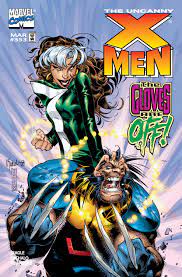 UNCANNY X-MEN vol 1 #353-354
UNCANNY X-MEN vol 1 #353-354
“Blackbirds” / “Prehistory”
by Steve Seagle, Chris Bachalo, Tim Townsend & Steve Buccellato
March & April 1998
Rogue has a recurring nightmare in which she first absorbs Wolverine’s powers and memory without his consent, then begs him to kill her for her lack of control. Rogue and Storm won’t tell him why she’s so jumpy, and he’s also generally annoyed about losing his temper with Marrow in X-Men #72, so Logan is generally annoyed.
At this point, Board of Education inspector Margaret Stone shows up, demanding to carry out a surprise inspection, since apparently Professor X hasn’t filed the necessary paperwork for over two years. She’s predictably horrified and quickly leaves, announcing that a full inspection will follow. In a depressing sign of things to come, this plotline simply vanishes into the ether without any resolution, after getting one further passing mention in issue #355. At any rate, Logan is having a very bad day, which only gets worse when he gets knocked out from behind by Sauron. He spends most of issue #354 unconscious, and finally wakes up in time to defeat Sauron. (Sauron is just hunting down mutant energy in this arc, and has no particular plan.)
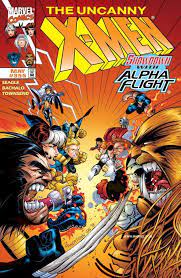 UNCANNY X-MEN vol 1 #355
UNCANNY X-MEN vol 1 #355
“North & South”
by Steve Seagle, Chris Bachalo, Tim Townsend & Steve Buccellato
May 1998
Wolverine is on his way to New York, partly to hand over Sauron to the authorities, and partly to look for Rogue. Instead, he gets attacked by Alpha Flight, who currently comprise Guardian (a clone of James Hudson), Vindicator, Puck, Sunfire, Flex (Adrian Corbo), Radius (Jared Corbo), Manbot (Bernie Lachenay), Murmur (Arlette Truffaut) and a new Sasquatch (just an actual sasquatch). At this point, Alpha Flight are being regularly brainwashed and manipulated by a particularly corrupt version of Department H, and they think they’re arresting Wolverine for the murder of Madison Jeffries. Eventually Alpha Flight figure out that they’re being manipulated, and head home. This is a basically an advert for Alpha Flight, which Seagle was also writing at the time; Alpha Flight vol 2 #9 tells the same story from Alpha Flight’s perspective.
 X-MEN vol 2 #73
X-MEN vol 2 #73
“The Elements Within Us”
by Joe Kelly, Joe Casey, Jeff Johnson, Dan Panosian & Steve Oliff
March 1998
This is mainly a Joseph issue, and Wolverine only appears in subplot scenes. The X-Men receive a blandly upbeat letter from Professor X, which Wolverine recognises as obviously heavily censored – he lashes out at his teammates when they try to see it as a positive sign. Later, the X-Men make new year resolutions; Wolverine’s is “to be the best there is at what I do, [as] soon as I figure out just what that is.” And Wolverine has a chat with Storm about Marrow – at least publicly, he’s insisting that his encounter with her went very well, but it’s pretty clear that we’re not meant to agree.
X-MEN vol 2 #74
“Rituals”
by Joe Kelly, Carlos Pacheco, Art Thibert, Chris Lichtner & Aron Lusen
April 1998
Logan investigates a series of violent murders in the Salem Centre area, which appear to be somehow connected to Maggott. Later, Logan wakes up in the snow, with an apparent post mortem scar healing on his chest, and Maggott apologising frantically nearby. Again, this is a subplot; the main story is about Marrow and Angel.
 X-MEN vol 2 #75
X-MEN vol 2 #75
“Anatomy of a Monster”
by Joe Kelly, German Garcia, Art Thibert & Digial Chameleon
May 1998
Maggott dumps Wolverine at the Mansion and apparently goes on the run. When he finally comes round, Wolverine insists that the X-Men go after Maggott, but Reyes points out that the scars on his chest are surgical and can’t possibly have been made by Maggott’s maggotts Eeny and Meany. The actual killers are the Ru’Tai, led by Pilgrimm – a demonic race who have emerged through the N’Garai cairn. Wolverine and Maggott wind up in the N’Garai dimension, where Pilgrimm defers to Wolverine as a cultural hero – apparently, the Ru’Tai were a slave caste who were inspired to rise up after Wolverine’s berserker rampage in the Wolverine ’95 annual. Wolverine is horrified by the thought that anyone would see his berserker rages as heroic, and be inspired by him to commit murders.
It’s a nice meta idea but heavily overplayed. Kelly wants us to buy that Wolverine is shaken to the core by this revelation, but that doesn’t really work for at least two reasons. First, the annual in question is a very incidental part of his history. And second, Logan has been fretting over his berserker rages and his humanity for years. In theory, “Logan is appalled to learn people think he’s admirable” could be an interesting angle, but… well, doesn’t he have the more junior X-characters for that?
Anyway, the X-Men defeat the Ru’Tai and escape back to earth, showing in the process that they’ve figure out how to work as a functional team.
Another flashback in Wolverine vol 2 #175 is placed here, with another annual attack on Matsuo Tsurayaba. Logan cuts off his nose this time.
 WOLVERINE vol 2 #123
WOLVERINE vol 2 #123
“Better Than Best”
by Tom DeFalco, Denys Cowan, Bill Sienkiewicz & Jason Wright
April 1998
The first of two outright fill-in issues by DeFalco, though at least the art is good, and DeFalco does try to tidy up some loose ends by having Wolverine reflect on the failure of his experiment at living in the East Village. That’s the last we’ll be hearing of it, though.
As for this issue’s story: Wolverine is captured and tortured by Roughouse and Bloodscream. There’s a lot of quite out-of-date material about Logan worrying whether he’s still up to par without his adamantium – it’s been nearly fifty issues by this point – but eventually he defeats both bad guys. DeFalco flags up a reasonable point that Bloodscream should actually be more scared of Wolverine without his adamantium – after all, Bloodscream is protected by a curse that says he can’t be injured by weapons forged by man, and while adamantium claws arguably fall within that rule, bone ones don’t.
No good reason is provided for Roughouse and Bloodscream being back together, or for Roughouse in particular to be back to villainy. They just are.
 WOLVERINE vol 2 #124
WOLVERINE vol 2 #124
“Invisible Destroyers!”
by Tom DeFalco, Denys Cowan, Bill Sienkiewicz & Jason Wright
May 1998
DeFalco is still writing Wolverine as worried about his recent performance in combat, which is at least some sort of hook for his two issues, but feels forced.
Wolverine teams with Captain America to fight Rascal and the Rodents, who have invisibility tech. The big idea is that Wolverine can still sense them with his other senses, but he wavers about it because he’s going through a period of self-doubt. Captain America is meant to represent a heroic standard that Wolverine aspires to, but that point doesn’t really come across. Quite a nice cover, though.
WOLVERINE vol 2 #125-128
“Logan’s Run!” / “Blood Wedding” / “I’m King of the World!” / “Green for Death”
#125-126 by Chris Claremont, Leinil Francis Yu, Edgar Tadeo, Gerry Alanguilan & Jason Wright
#127 by Chris Claremont, six pencillers, four inkers and two colourists (!)
#128 by Chris Claremont, Stephen Platt, Angel Unzueta, various inkers & Wayne Robinson
June to September 1998
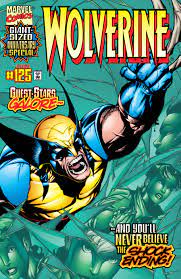 Chris Claremont returns for the anniversary issue, and boy, is this a mess. Not only does the regular penciller draw only half the arc – with the rest cludged together by whoever was passing – but it was initially planned as a six issue arc and cut to four issues while it was in progress. The result is so chaotic that even Marvel’s official Wolverine Index openly speculates that lettering has been placed to obscure plot elements that had to be cut at the last minute. But even the first chapter doesn’t make a great deal of sense. So. Deep breath.
Chris Claremont returns for the anniversary issue, and boy, is this a mess. Not only does the regular penciller draw only half the arc – with the rest cludged together by whoever was passing – but it was initially planned as a six issue arc and cut to four issues while it was in progress. The result is so chaotic that even Marvel’s official Wolverine Index openly speculates that lettering has been placed to obscure plot elements that had to be cut at the last minute. But even the first chapter doesn’t make a great deal of sense. So. Deep breath.
Issue #125 tries to define Wolverine by the women who know him; the man himself doesn’t appear until the end, and Kitty Pryde takes over as narrator for the issue. Viper poisons Phoenix, Psylocke, Tyger Tiger, Yukio, Rogue, Jessica Drew and Shadowcat in order to brainwash them so that they will find Wolverine for her. But Shadowcat escapes her control, then rescues Jubilee when Viper tries to get her. Everyone tracks Wolverine to Madripoor, where the brainwashed telepaths torment him with memories of the deaths of Mariko and Silver Fox. Black Widow shows up to complete the set of Important Women in Wolverine’s Life. Viper then explains that this was all an elaborate scheme to locate Wolverine so that she can call in a favour, and Wolverine explains that Viper is his wife. Somewhere in here, Kitty gets to restate that Wolverine is the self-appointed keeper of the X-Men’s conscience – hence everyone’s disappointment that he has anything to do with Viper.
The wheels are coming off right from the start. If Viper controlled everyone else with poison, why is the attack on Jubilee telepathic? How does poison let Viper control any of these women? And if Viper is able to locate and brainwash Phoenix and Psylocke, why one earth does she need such an elaborate scheme just to find Wolverine? There are no answers.
Issue #126 then makes matters worse by revealing that, actually, Viper isn’t Wolverine’s wife; he’s just honouring a promise to marry her. That promise was made decades ago, after she rescued him from Sabretooth on the mission were Seraph died. All the women are appalled that Wolverine would marry Viper and leave, except for Kitty (though Jubilee at least tries to stay). Logan and Viper are duly married, and Sabretooth immediately attacks. For reasons that are never revealed, Sabretooth now has a vastly powered up healing factor and his own adamantium skeleton. So he shatters Logan’s claws, and Kitty has to throw Logan into the sea. Meanwhile, HYDRA and the Hand are trying to take over Madripoor in the power vacuum left by Baran’s death. In a screeching gear change, issue #127 focusses on Wolverine impersonating various superheroes to make them think they’re facing an army. Sabretooth also opposes this takeover, since he believes that a HYDRA-run Madripoor would be a fascist dictatorship, without the chaos that he loves.
This all leads to Wolverine, Shadowcat and Sabretooth collaborating to instal Viper as the new ruler instead. Issue #128 has a weird sequence in which the Hand somehow alter characteristics between the three, with Wolverine acquiring Kitty’s innocence, Kitty taking Sabretooth’s ferocity, and Sabretooth getting Wolverine’s sense of honour – none of which would be particularly apparent if the dialogue didn’t spell it out directly. Claremont is clearly trying to do something about parallels between the characters. When the effect wears off, Wolverine claims that being exposed to a sense of honour will slowly drive Sabretooth mad, and show that he’s the inferior one… none of which will happen. Finally, Viper banishes all three of Wolverine, Shadowcat and Sabretooth from Madripoor – despite the fact that we were told earlier in the issue that she can only hold the position of prince thanks to the credibility she gets from her marriage to Wolverine. That was why she wanted the marriage. But… she can openly banish Wolverine himself and still benefit from that? How does that work?
This is a genuine disaster. Nobody really knew what to do with the Viper-as-wife concept either – it hangs around for a while being ignored until Frank Tieri quite reasonably gets rid of it. But we’ll come to that.
 WOLVERINE vol 2 #129-130
WOLVERINE vol 2 #129-130
“Survival of the Fittest”
by Todd DeZago, Leinil Francis Yu, Edgar Tadeo & Jason Wright
October & November 1998
Another fill-in. In the aftermath of the previous arc, Wolverine is worrying about whether he’s lost his edge. He was similarly preoccupied in the Tom DeFalco issues, so perhaps this was the direction coming from editorial.
While revisiting the Weapon X facility, he encounters a new Wendigo (Andre Mornet) and gets badly injured while driving it off. Farmer’s son Tommy Jarman nurses him back to health over three days, until Logan finally regains his senses and realises that the Wendigo will be coming after him. He finally drives the thing away by setting it on fire and hitting it with an axe, lamenting to Tommy that in the end they are both just doing what it takes to survive. The irony is that poor Mornet became the Wendigo after being trapped under a felled tree and eating his own flesh, so he’s fallen foul of the letter of the Wendigo curse without doing anything beyond trying to survive. It’s meant to be a story about the limits of morality in life-or-death situations.
It’s tempting to roll one’s eyes at the fact that Marvel cut short Claremont’s arc only to go back to running fill-in story… but this is actually pretty good, and certainly better than what it replaced.
 X-MEN vol 2 #76
X-MEN vol 2 #76
“A Boykie and his Dinges”
by Joe Kelly, Mat Broome, Sean Parsons & Liquid!
June 1998
Wolverine plays the voice-of-authority, voice-of-experience father figure, as Maggott finally reveals his origin story in an extended flashback. He also gets to see Storm receive a mystical message from her “mother” Ainet, summoning her to battle Ananasi.
UNCANNY X-MEN vol 1 #356
“Reunion”
by Steve Seagle, Chris Bachalo, Tim Townsend & Steve Buccellato
June 1998
In a one-page subplot, Wolverine finally gets around to handing Sauron over to S.H.I.E.L.D. Obviously there isn’t supposed to be such a long gap between issues #355-356, but the intertitle continuity at this point was just a bit garbled.
 X-MEN vol 2 #77-78
X-MEN vol 2 #77-78
“Psi-War”
by Joe Kelly, German Garcia, Art Thibert & Liquid
July & August 1998
The X-Men battle Ananasi, who turns out to be the Shadow King. A discharge of psi-energy is released during the battle, which disrupts the psychic plane worldwide – this seems to have been intended as a device to downgrade Marvel’s overpowered telepaths, but it soon gets forgotten about. Eventually Psylocke contains the Shadow King within her mind.
Wolverine is just there as part of the regular cast – Shadow King torments him with past traumas, but it’s all familiar stuff and Kelly clearly has no real interest in going over it again.
UNCANNY X-MEN vol 1 #359
“Power Play”
by Joe Kelly, Steve Seagle, Chris Bachalo, Ryan Benjamin and various others
September 1998
Wolverine only appears on the last page, welcoming Rogue back to the Mansion.
 WOLVERINE #900
WOLVERINE #900
“Desperate Measures”
by Todd DeZago, Jason Craig & Thomas Mason
July 2010
Wolverine #900 was an anthology one-shot. The bizarre numbering is because Deadpool had already done an issue #900 – in that case, it was a meta joke to do with DC’s anniversary issues of the time, but Marvel seemed to have completely forgotten that by the time Wolverine #900 shipped.
The X-Men stop three Sentinels from attacking the Morlocks, and Wolverine uses his claws to perform emergency surgery on a Morlock. (Along with various one-shoot characters, he meets Ape for the first time.) A footnote expressly says this takes place around this time, but it doesn’t read at all well in sequence. For one thing, Wolverine’s wrongly drawn with adamantium claws. More fundamentally, the basic premise is that Marrow and Wolverine both think of themselves as living weapons; and Wolverine shows that his powers can be used constructively, specifically for emergency surgery.
It’s not a great story to start with, but in a chronological read through, it suffers even more from the fact that the same basic idea is worked into X-Men #70, which does it better.
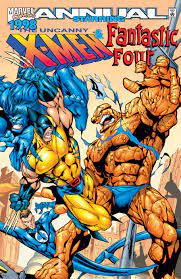 UNCANNY X-MEN / FANTASTIC FOUR ’98
UNCANNY X-MEN / FANTASTIC FOUR ’98
“Thresholds”
by Joe Casey, Paul Pelletier, Leo Fernandez and various others
1998
The X-Men and the Fantastic Four team up to defeat bitter scientist Bradley Beynon and the Psycho-Man. Marvel did a wave of team-up annuals in 1998, but this one is close to being a Fantastic Four story with the X-Men as guest stars. There’s a bit of schtick based on Wolverine and the Thing being the blue collar guys on both teams, but that’s about it.
WOLVERINE vol 2 #131
“It Fell to Earth”
by Todd DeZago, Brian K Vaughan, Cary Nord, Scott Hunter & Kevin Tinsley
November 1998
Viper sends a reluctant Wolverine to Shangri-La to recover a “pure” sample of a virus which infected previous explorers, and is now supposedly rife in Madripoor. Viper claims that she needs the sample to develop a cure. During the mission, Wolverine realises that he’s just being used to recover a bioweapon and there is no public health risk. The “virus” inexplicably turns out to be a giant spider; Wolverine destroys it, and fulfils his promise to Viper by bringing back a sample but then immediately destroying it.
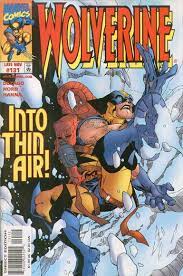 At least this tries to do something with the Viper status quo, and there’s an okay plot in there somewhere, but the virus/spider stuff doesn’t make much sense. It’s one of Brian K Vaughan’s early scripting jobs, and he’s already doing his trademark factoids. (“One out of seven. That’s how many people die trying to conquer these old hills…”)
At least this tries to do something with the Viper status quo, and there’s an okay plot in there somewhere, but the virus/spider stuff doesn’t make much sense. It’s one of Brian K Vaughan’s early scripting jobs, and he’s already doing his trademark factoids. (“One out of seven. That’s how many people die trying to conquer these old hills…”)
Capping off a less than stellar year for the X-office, this issue was notoriously recalled after it somehow managed to see print with a racial slur in the dialogue. The corrected version reads “killer”. The story goes that it was a hand-written editorial change to the script and the letterer misread it on the fax. He didn’t know what the word meant but apparently figured that if the spell checker was okay with it, it must be fine – and the book was running so late that it wasn’t properly proofread. Strange as all this sounds, it’s clear that something along these lines must have happened, since the dialogue in question relates to Sabretooth, and the original version just doesn’t make any sense.
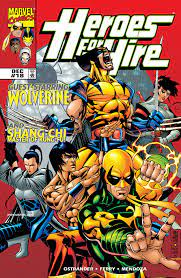 HEROES FOR HIRE vol 1 #18-19
HEROES FOR HIRE vol 1 #18-19
“Danny and the Pirates” / “Sold Outs!”
by John Ostrander, Pascual Ferry, Jaime Mendoza & Joe Rosas
December 1998 and January 1999
Guest star outings to the wider Marvel Universe were rare in the late 90s, and this is the only one we really get this year (aside from the FF team-up annual).
A priceless statue of Mulan is secretly auctioned in Madripoor, having supposedly been stolen by Viper. Wolverine investigates, suspecting that Viper has been framed for political reasons. Also investigating are Jessica Drew and the Heroes for Hire – Iron Fist, Colleen Wing, Shang-Chi and Cat (Shen Kuei). The true villain turns out to be Chinese General Lo Chien, who is trying to assemble culturally important artefacts in order to build a power base for himself when Chinese Communism eventually falls. Well, it’s certainly a novel motivation. Wolverine derides the Heroes for Hire as a bunch of amateurs, but Iron Fist gets the chance to save him in the end.
 WOLVERINE: BLACK RIO
WOLVERINE: BLACK RIO
One-shot
by Joe Casey, Oscar Jimenez, Eduardo Alpuente & Gina Going
1998
This is essentially the 1998 annual. In Rio, Logan helps his old friend police officer Antonio Vargas investigate “vampire killings”, where victims have been drained of blood. Logan and Vargas encounter apparent vampires, among them Vargas’ missing wife Ezra Asher, who promptly kills him. Continuing the investigation alone, Wolverine learns that vampire leader Cyrus Leviticus is not a true vampire, but rather bonded to some sort of symbiote. Cyrus plans to slaughter Rio’s carnivalgoers for personal power, but Logan kills the vampires, the symbiote and Cyrus. He visits Vargas’s grave one more time before leaving.
It’s a slight story with a weak ending, but the first half is pretty good and the art is lovely. Partygoer Logan is a bit weird, but it kind of works – he’s on holiday and away from the people that he normally keeps up a front around, after all. There are some interesting parallels drawn between Wolverine’s immortality and the undead, too. But it just kind of ends in a fight against villains who don’t feel like a threat.
AVENGERS vol 3 #10
“Pomp & Pageantry”
by Kurt Busiek, George Perez, Al Vey & Tom Smith
November 1998
The X-Men have a brief cameo, watching the Avengers on TV.
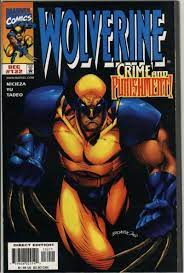 WOLVERINE vol 2 #132
WOLVERINE vol 2 #132
“A Rage in the Cage”
by Fabian Nicieza, Leinil Francis Yu, various inkers & Jason Wright
December 1998
Remember the Higgins family and their abusive father Bob, from way back in issue #91? Well, when Linda is killed and daughter Jane is hospitalised, Logan is convinced that Bob is to blame, and hunts him down. But Linda was actually killed by son Richie, who was trying to stop her from shooting Bob in self-defence. Logan says it was still Bob who really killed them. A fill-in story, but one that ties up a loose end and tries to disavow the uncomfortable moral problems of the original story – with hindsight, Logan now believes that he was too proud of keeping his composure the first time round.
UNCANNY X-MEN vol 1 #360 / X-MEN vol 2 #80
“Children of the Atom”
#360 by Steve Seagle, Chris Bachalo, Tim Townsend, Shannon Blanchard & Mike Rockwitz
#80 by Joe Kelly, Brandon Peterson, Art Thibert & Liquid!
October 1998
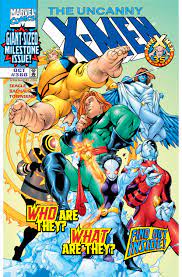 Things aren’t going so smoothly in the X-office, so… time for another relaunch. Peter Corbeau is kidnapped, with the X-Men as prime suspects. And Professor X has gone missing from government custody. The trail leads the X-Men to Cape Citadel where they come under attack from rival “X-Men” (Chaos, Crux, the Grey King, Landslide, Mercury and Rapture) who answer to their own “Professor X”. The “X-Men” are trying to hijack a new and sinister-sounding “mutant defence net” for their own purposes. Wolverine identifies that “Professor X” isn’t even human; the “Professor” confirms that, and claims to be “the ultimate extension of Charles Xavier’s most noble designs”.
Things aren’t going so smoothly in the X-office, so… time for another relaunch. Peter Corbeau is kidnapped, with the X-Men as prime suspects. And Professor X has gone missing from government custody. The trail leads the X-Men to Cape Citadel where they come under attack from rival “X-Men” (Chaos, Crux, the Grey King, Landslide, Mercury and Rapture) who answer to their own “Professor X”. The “X-Men” are trying to hijack a new and sinister-sounding “mutant defence net” for their own purposes. Wolverine identifies that “Professor X” isn’t even human; the “Professor” confirms that, and claims to be “the ultimate extension of Charles Xavier’s most noble designs”.
The impostors are repelled, the mutant defence net is destroyed in the fight, and the real X-Men naturally get all the blame. During all this, Colossus, Shadowcat and Nightcrawler rejoin the team (following the cancellation of Excalibur), joining Wolverine, Storm, Rogue and Marrow as the new roster. A coda establishes that the “Professor” is actually Cerebro, which has developed A.I. thanks to Operation: Zero Tolerance’s tinkering.
There are some nice incidental character moments in Kelly’s issue: Wolverine still bears a grudge against Colossus for joining the Acolytes. He’s especially concerned about his close friend Nightcrawler. And he derides the younger X-Men for voicing their doubts about the plan, only to turn round and quietly raise exactly the same concerns himself with Storm.
X-MEN vol 2 #½
“Thrall”
by Todd DeZago, Mike Wieringo, Brad Vancata & Mark McNabb
1998
The X-Men defeat Mesmero, despite his illusions making them think that they’re in a medieval world.
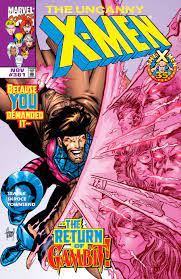 UNCANNY X-MEN vol 1 #361
UNCANNY X-MEN vol 1 #361
“Thieves in the Temple”
by Steve Seagle, Steve Skroce, Tim Townsend & Shannon Blancard
November 1998
This is mostly a Storm and Kitty story, involving the return of Gambit. In subplots, Wolverine tells Rogue that she’s obviously still hung up on the missing Gambit. And when Colossus mentions that Wolverine is in his old room (intending to make the point to Marrow that it really doesn’t matter), Wolverine promptly offers to give it back. As played here, it comes across as if Wolverine’s going to go and sleep rough in the grounds again, but mercifully that’s not what happens – when we next see his living arrangements, in issue #365, he’s moved into a log cabin.
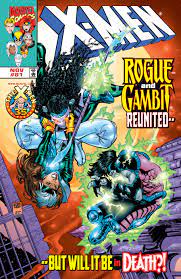 X-MEN vol 2 #81
X-MEN vol 2 #81
“Jack of Hearts, Queen of Death!”
by Joe Kelly, Adam Kubert, Mark Farmer & Steve Buccellato
November 1998
The X-Men finally have the Danger Room up and running again – albeit with non-Shi’ar technology – and they train in it for the first time in ages. Wolverine and Marrow are still butting heads, and Nightcrawler queries whether Wolverine is really going the right way about winning her over. Later, Wolverine also talks to the newly-returned Gambit – he’s open to giving Gambit a second chance even after everything, but gives him a stern warning about not breaking Rogue’s heart again. This is Wolverine as the team patriarch.
A more interesting scene has Wolverine and Kitty discussing Gambit’s return; she doesn’t know or trust him, and Wolverine teases her by suggesting that he reminds her of Pete Wisdom. There are nice bits in all this, but we’re in a phase that suffers badly with hindsight, because it all proves abortive when the next relaunch comes.
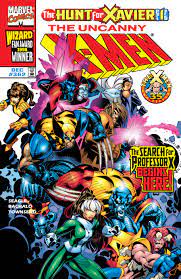 UNCANNY X-MEN vol 1 #362-364 / X-MEN vol 2 #83-84
UNCANNY X-MEN vol 1 #362-364 / X-MEN vol 2 #83-84
“The Hunt for Xavier!, parts 1 and 3-6”
UX #362-363 by Steven Seagle, Chris Bachalo, Art Thibert, Tim Townsend & Liquid!
UX #364 by Steven Seagle, Ralph Macchio, Leinil Francis Yu, Tim Townsend, Edgar Tadeo & Liquid!
X #83-84 by Joe Kelly, Adam Kubert and various
December 1998 to February 1999
The X-Men hunt for Professor X using Muir Isle’s spare Cerebro. But confusingly, it comes up with two signals. Wolverine joins Nightcrawler, Shadowcat and Marrow in following one of the signals to the Golden Gate Park, where Logan’s old friend Black Crane (now a herbalist) points them to Alcatraz. There, they find the new Brotherhood of Evil Mutants (Blob, Mimic, Post and Toad) protecting the real Professor X from Cerebro. Cerebro sends Cerebrite-Beta to recover him, and it manages to teleport Professor X, Wolverine and Shadowcat (among others) away to join the final battle against Cerebro. Cerebro turns out to be a standard “AI takes its mission too literally” villain: it plans to “catalogue” the whole human race and create peace by sticking everyone in cocoons. Nina, one of the mysterious nanotech-based Mannites that Professor X met in government custody, restores Professor X’s telepathy; he then defeats Cerebro by telepathically showing it the variety of human minds, which apparently somehow makes it cease to exist as an AI.
That ends the abortive Kelly/Seagle run on the X-Men, with most of the outstanding plots simply being abandoned. The whole thing is a desperate waste of talent, both of writers and artists.
 X-MEN: LIBERATORS
X-MEN: LIBERATORS
4-issue miniseries
by Joe Harris, Phil Jimenez, Keith Aiken & Shannon Blanchard
November 1998 to February 1999
Logan and Kurt accompany Peter back to Russia to commemorate his parents’ deaths. Logan and Kurt are attacked by a monstrous mutant boy, Nikolas, who has the power to wither living things around him. Logan claws Nikolas in self-defence before succumbing to his power. Province 13, a Russian government project searching for Russian mutants, take Wolverine away. Astoundingly, the Russian scientists – who are experts in the field of mutants, and actually notice his healing powers and claws – fail to recognise him as Wolverine and dump his body, whereupon he promptly heals. The X-Men rescue a bunch of children from Province 13, fighting Omega Red in the process. Nikolas helps to defeat Omega Red, but is killed by his own estranged mother as an act of mercy; she takes in one of the Province 13 children, Nanya, as her foster daughter.
This is mainly a Colossus story, despite Logan and Kurt getting co-billing as stars. It’s above average for a random miniseries, but the main draw was Jimenez’s pencils, and he scales back to doing breakdowns with issue #2. In theory the Wolverine angle here would be exploitation of mutants by the authorities, but he’s really just here to add star power.
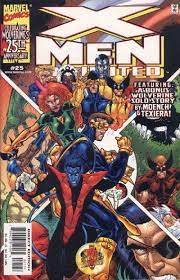 X-MEN UNLIMITED vol 1 #25 (backup story)
X-MEN UNLIMITED vol 1 #25 (backup story)
“Game”
by Doug Moench, Mark Texeira & Marie Javins
December 1999
In a bar in Manitoba, Logan reflects once again on the difference between men and animals. He drives off some obnoxious yuppie hunters who the locals tolerate for the tourist income. As he burns their kills on a funeral pyre, he reflects that even though men have greater powers of thought, there is more nobility in beasts.
It’s nothing you haven’t heard before, and it’s done with some rather clumsy speechifying – it even has Logan reciting John Donne’s “Death Be Not Proud”, which doesn’t feel to me like the sort of thing he’d be memorising.
Next time, Wolverine enters 1999 and the Erik Larsen era.

I’d more or less abandoned the books by this point (before returning in 2000/2001) but what was the go with the Claremont Wolverine run – Why did they bring him back and what went so badly wrong behind the scenes which led to things getting cut off early?
“That ends the abortive Kelly/Seagle run on the X-Men, with most of the outstanding plots simply being abandoned. The whole thing is a desperate waste of talent, both of writers and artists.”
It truly is a shame given the interesting ideas that were trying to get out. I rejoined X-Men as Excalibur was cancelled. It felt like Nightcrawler, Shadowcat and Colossus had fallen through a regression time warp, which I understand was the specific editorial intent.
“So he shatters Logan’s claws, and Kitty has to throw Logan into the sea.”
Having not read these stories myself, sometimes the recaps just sound like X-men related poetry. Which is the best.
This was the era of the Joes at Marvel. Joe Kelly. Joe Casey. Joe Harris.
There is a distinct lack of Joes with today’s X-books.
Oh man, Claremont’s return to Wolverine… I read all four issues. Why? Because, against all evidence, maybe the next one would be good. Claremont just needs to find his feet again, and then the book will be back on track. I like Yu’s art, so this series will turn around aaaaany minute now…
A couple years later, I gave Claremont exactly one story on each title, saw the results, then bailed. I’m glad X-Treme X-Men (or which I’ve only read the first issue) worked better for him, but those Wolverine & Revolutions X-Men issues are the perfect demonstration of “you can’t go home again.”
Boy, it’s been a long time since I thought about Grey King and company. The gimmick was that they were all kind of mash-ups of existing mutants, created by Cerebro from its files, right? But apart from few obvious similarities, we never really got a good grasp of exactly who they were mash-ups of?
This is where I started reading X-Men. Reading this entry it seems remarkable that I’m still reading now.
Not a great batch. Even the Seagle/Kelly stuff is meh.
I think the official Fantastic Four annual that year was Fantastic Four/Fantastic Four.
Liberators was boring. I read Black Rio but can’t remember it at all.
That Viper wedding story was a mess. It’s starts out like a dream sequence but they never have a scene where Wolverine wakes up…
Skrull Wolverine is coming. The Alan Davis run is nobody’s favorite and not every beat is good, but I still think people will see it holds up better than they remember.
Wow, 5-6 different writers in a single year ? Wolverine was really deep in the doldrums in 1998.
(And somehow despite all these fill-ins, Yu drew no less than 7 issues this year, as well guesting on Uncanny.)
Daibhid C- yeah they really get rid of the Cerebri X-Men quickly without going into too much detail.
Isn’t it that Apocalypse gave Sabertooth the adamantium as a trial run before he captures Wolverine to do the same thing and turn him into Death?
Or at least that’s the explanation they eventually gave after Skrullverine?
I never read Wolverine: Black Rio, but I feel like Oscar Jimenez is the most underrated Jimenez in comics. I mean Phil and Jorge are amazing, but I always liked Oscar’s style.
It all sounds like varying levels of dreck. Some goopy, black and smelling of sulphur. Some just silty and watery. But all dreck nonetheless.
And that cover of #355 is exhibit A in why I hate the art of this era.
Generally, in a “serious” comic book I prefer the art to be in a realist style, though I can also get behind more abstract work or work that’s experimental and innovative. But I just can’t stand cartoonishness except in a story that’s meant to be a satire.
I wasn’t well aware of this turn of Cerebro’s history. According to the Marvel Fandom wiki it went by the name “Founder” at that point.
Nor am I aware of the origin of Danger as a character. I wonder if there is any connection to Founder’s.
AFAIK there was never since any hint that Cerebro might be sentient again. But stranger things have happened, and this Krakoa era is about as interesting a time for that to happen as any time could be.
Not a fan of that cover, but I for the life of me (despite his signature right there on the thing) am not convinced that Chris Bachalo and Tim Townsend did it. Everywhere I look, it’s credited to them, but Bachalo is the one artist I always felt layered in enough baroque atmosphere into his work that he made a more ‘cartoony’ style work. The 355 cover is so banal and flat. Reminds me more of Joe Mad or Roger Cruz.
I like that art!
It’s a man named after a weasel fighting an actual sasquatch.
It is a cartoon.
PS- I was researching my Sabertooth assertions and went back to those issues. It’s never explicitly stated where he got the adamantium. Don’t know if that detail about Apocalypse was ever explicitly stated somewhere or it’s just head cannon, but I’m not the only one to come to that conclusion.
Weird!
That cover is truly bad. Too much mouth. It does have Bachalo linework, especially if you look at Storm and Puck in the background. Maybe Townsend penciled it and Bachalo inked it. Or it was inked from a sketch.
The only other place I remember Oscar Jimenez’s art is on that 2-parter about The Key from early JLA. Loved his work there, especially in the Green Lantern from Krypton scenes.
Thom H. said: The only other place I remember Oscar Jimenez’s art is on that 2-parter about The Key from early JLA. Loved his work there, especially in the Green Lantern from Krypton scenes.
Oscar Jimenez had a stint on Mark Waid’s Flash title; he was the artist who replaced Mike Wieringo after the big #100th issue sequence, and Jimenez pencilled the stories that introduced Savitar.
He left midway through a later arc, which was already doing some fill-in and “this sequence by one artist, this sequence by another” thing, and was replaced by Paul Ryan. His JLA two-parter would have been about a year after that.
As a jokey side note, this Paul Ryan is the penciller who worked on the final issues of the original Squadron Supreme miniseries and was the main artist for Tom DeFalco’s Fantastic Four, not the American conservative politician.
Oscar Jimenez also drew the first arc of Stormwatch vol. 2, right before the introduction of the Midnighter and Apollo. It looked good, but the next artist on the book was Bryan Hitch. Stormwatch v2 became the Authority, and he became one of the most popular artists of the era while Oscar Jimenez was kind of forgotten.
Chris Bachalo of this period is real hit-or-miss. He leaned a bit far into exaggeration, and drew some characters inconsistently. I’ll take his art over the manga wannabes of the time, though.
Fun fact:The John Bolton who did artwork on Classic X-Men really is the American neoconservative in disguise. He said it was satirical street theatre which got completely out of hand.
Oscar Jimenez’s career imploded working on, of all things, the Avatars miniseries, which is basically medieval Avengers spinning out of the first arc of Busiek/Perez’s Avengers run. Tom Breevoort said of him: “Oscar Jimenez fell apart halfway through the project, requiring us to bring in other diverse hands to finsih [sic] it up.” He adopted a pseudonym later in the 2000s and then seemingly vanished. No idea what the story is there. Shame, since I always liked his work.
Re: the Cerebro X-Men, from Paul’s X-Men Index recaps: “The Gray King is Jean Grey/Phoenix crossed with Sebastian Shaw. (He also has a “psionic dampening” power which might have been drawn from Chance II of the Fallen Angels.) Chaos is the name and powers of Havok crossed with Legion. Mercury is apparently meant to be a cross between Magneto, Quicksilver and Wolverine. Rapture is the Angel crossed with Mystique, although with religious overtones above either of them (possibly drawn from Wolfsbane). Crux is particularly difficult to make sense of and would seem to be a cross between Jubilee and ultra-obscure Spider-Man villain Equinox, The Thermodynamic Man, although that does seem very unlikely to be the intention. Earthquake is the Blob and Sabretooth.”
Wikipedia has the Cerebro X-Men listed as slightly different and seems to be using an interview with Carlos Pacheco for the information.
Crux-powers of Iceman and Sunfire with the personality of Jubilee.
Grey King-Jean Grey/Sebastian Shaw
Landslide-powers of Beast and Sabretooth with the personality of Rogue.
Mercury-Colossus and Wolverine
Rapture-appearance of Mystique, power of Archangel, and personality of Nightcrawler
Chaos/Kaos-Cyclops and Havok
It mentions that some of Pacheco’s original designs were changed.
It also has Earthquake’s name listed as Landslide.
I think the basic idea was they were the original x-men mixed with the Brotherhood. Might have been a little muddled on final execution of the idea.
I wonder if Claremont’s weirdly truncated Wolverine run was another example of his trying to refit old plots he was prevented from seeing through.
In this case, there seem to be some elements of his supposed plan for Uncanny X-Men #300, which would’ve seen Wolverine brainwashed into evil by the Hand, and Claremont’s other idea for some kind of massive battle to the death between Wolverine and Sabretooth after Sabretooth kills Mariko.
Here, it seems like there are some inversions of those ideas. The Hand are seen running around Madripoor, and instead of a beloved fiancee it’s a hated foe he’s required to marry. Instead of Wolverine being brainwashed into attacking the X-Men, it’s the X-Men he most cares about brainwashed to attack him. And Sabretooth turns up super-powerful.
At a guess, I’d say the Viper marriage plot point was supposed to go somewhere different, and may have gotten the story cut down. It was, as Paul notes, studiously ignored by other writers until it could be quickly written out, and it seems like something that meant to play out as a big status quo shift.
It also seems that Mark Millar’s “Enemy of the State” and “Old Man Logan storylines years later in the Wolverine solo title bear some (accidental?) resemblance to the rumored, aborted Claremont stories, since both of them have Wolverine being mentally manipulated into killing fellow X-Men by the villains.
However, Millar has also stated that the whole “villains killed all the heroes” thing was a childhood lie his brother told him that stuck with him, and the Hand brainwashing or manipulating people into evil is an old Frank Miller bit from the 1980s Elektra stories. So I doubt Millar had these rumors in mind, or even knew of them.
As I recall it, there was a lot of expectation at the time for Wolverine to regain his adamantium.
Claremont acknowledged that demand in interviews but was a bit flippant about it, claiming that the adamantium was back, it just wasn’t in Wolverine.
Just an uneducated guess of mine, but I would not be too surprised to learn that Marvel editorial got too nervous about giving Claremont quite as much leeway at the time (Marvel was under Chapter 11 bankrupcy at the time, in negotiations to be acquired by Toy Biz, and there was a settlement by Ron Perelman right around this time). They may have decided to cut his run short and ensure the return of the adamantium.
Of course, that still took about a year and a half, so maybe not.
Good to know about Oscar Jimenez. I must have seen some of his other work because I think I read those books(?), but I don’t remember it. In any case, I hope he’s okay. The end of his comics career sounds pretty dramatic.
“Chaos is the name and powers of Havok crossed with Legion.”
That seems really dangerous.
They made Chaos autistic, like Legion was… Except Legion was never actually autistic. He was believed to be autistic because he was nonverbal and disconnected from reality. It was the ’80s, so I give Claremont & co a slight pass on understanding autism. Almost every media depiction of autism was poorly done until fairly recently. I say this as someone who has worked with autistic students for over 20 years.
Chaos had this weird speech pattern where he’d say single words or short phrases, often related to whatever he was doing with his power. Plenty of autistic people communicate in single words and short phrases, but not the way Kelly & Seagle wrote it, as semi-non-sequiturs. It read like they heard that many autistic people have communication challenges but didn’t get how they manifest.
Maybe Chaos was a Dadist and people mistook it for autism.
“I just can’t stand cartoonishness except in a story that’s meant to be a satire.”
I really like Bachalo, but #355 really isn’t among his best work. And come to think of it, I’m not a big fan of his work on the main X-Men titles (in any era). Anything offbeat from him is welcome.
And on that note, while I don’t hate Humberto Ramos as an artist, I hate his art on any big name title. I hated his Spider-man work immensely.
Mike Loughlin
It’s funny you mention that StormWatch run – I quite like the 2.5 issues of it he drew (They brought Hitch and I think Michael Ryan in to finish the third and last issue of that arc), particularly the design for Jackson King as Weatherman, though clearly neither Ellis or Hitch did because the team got new costumes again for the second time in four or five issues.
And then the cast got slaughtered five issues later to make way for The Authority. Very weird.
Paul’s original reviews he wrote in the late 90s for many of these issues were quite interest to read in the context of the time.
Not technically an X-book but his take on Rob Liefeld’s Captain America 6 was glorious.
Josie said: And on that note, while I don’t hate Humberto Ramos as an artist, I hate his art on any big name title. I hated his Spider-man work immensely.
I also found Ramos really frustrating on the Spider-titles. It felt like his panel layouts and panel-to-panel storytelling got looser and less effective the longer he was there. There’s always been a certain weightlessness to his figures and his action sequences, and that really messes up the usual contrasts between Spider-Man agility and his slower, powerhouse foes.
I’m amazed that sentient Cerebro never appeared again.
If Black Rio had been labelled as an annual there’d have been more chance I’d have at least given it a look, but my brain had been trained at this point to avoid (most) one-shots.
Yeah, I’ve never been able to stand Chris Bachalo’s work since it became the stuff it’s been for the last 25 years. Wolverine on those covers looks like more like Feral Wolverine than normal Wolverine.
Luis Dantas> AFAIK there was never since any hint that Cerebro might be sentient again. But stranger things have happened, and this Krakoa era is about as interesting a time for that to happen as any time could be.
Dave> I’m amazed that sentient Cerebro never appeared again.
“GOOD NEWS!” Benjamin Percy’s doing it again in upcoming issues of X-Force.
“I forced my telepathy helmet to record over one million mutants then make its own protagonists. This is what happened.”
“There’s always been a certain weightlessness to his figures and his action sequences, and that really messes up the usual contrasts between Spider-Man agility and his slower, powerhouse foes.”
I think that’s a pretty good description. I remember Spider-Island just being a visual nightmare. And I guess what was more frustrating is that they went with Ramos after having artists like Marcos Martin and Phil Jimenez on the book.
(Actually I thought Jimenez was also a bad fit. He does great work, but it didn’t feel like a good fit with Spider-man. Sam with Michael Lark.)
I used to love Ramos’s work on Impulse, even though I’ve never liked the pseudo-manga stylings of many late-’90s artists. The book was a lot of fun, mixed with some heavy emotional beats. Ramos was good at both. His next major project was DV8, a Gen-13 spin-off about (mostly) villainous teens written by Warren Ellis. Ramos’s cartooniness was a terrible fit for the genuinely unpleasant series. After that, he did Crimson, a creator-owned horror series. When he came back to Marvel, I think his years drawing dark stuff sapped some of the bounciness from his art. That, and his figures and faces became more sharply angular. I haven’t liked his art since.
“Actually I thought Jimenez was also a bad fit. He does great work, but it didn’t feel like a good fit with Spider-man. Sam with Michael Lark.”
Spider-Man worked best when the artist is skilled at rendering fluid movement. Jimenez and Lark are both great, but their strengths lie elsewhere.
Ramos’s art also suffered from the shift towards digital inking and computerized, shaded coloring, which tended to clash with the stylized, cartoony, and exaggerated figures and facial expressions that worked so well on Impulse.
I feel like similar things happened to artists like Larry Stroman in his abortive return to Peter David’s Madrox-focused X-Factor series and to Frank Miller on some of his later work (which was also not helped by Miller’s decay as a writer).
There’s a whole school of comics art that just works better with the older, flatter coloring and becomes muddy, smudgy, and ugly with digital color blending and softer ink lines. It’s as if the pencil art is fighting the rest of the presentation.
I still think Ramos’s layouts and storytelling worsened over the years, and even in Impulse the (thankfully rare) big fight scenes were almost always the least effective parts of the book.
Man, the combination of pencillers with certain inkers and colorists is a whole topic I’ve become really fascinated by in the last few years, and which I still have a lot to learn about.
For example, I’ve always liked Ivan Reis’s art, especially when inked by Joe Prados and O’Clair Albert, and recently Danny Miki took over inking Reis’s pencils, and I DO NOT LIKE IT.
Meanwhile, Romita Jr. is usually inked by Klaus Janson, Scott Hanna, etc, some are okay, some not so much, but then I saw Danny Miki inking him on Superman: Year One and I thought it looked really good.
And it’s like . . . there are no wrong styles, but there are styles that clash, and you never really know until you see it happen.
There are some artists I really like who do their own coloring frequently: James Stokoe, Chris Bachalo, Sean Murphy. I love their pencils and inks, but I hate their coloring!
Maybe sentiment Cerebro should become a power couple with Danger.
Scrolling through these covers, I realized all the ones I hate are by Bachalo. Rogue’s face on that first one. The big bulbous chin and blubbery feet and legs on #360. All just ugly to my eyes. I confess, figure is the often the first and sometimes last thing I see, so there might be something there behind all that worth a second look.
And indeed, every once in a while I see work by Bachalo and whatever appeals to everyone kind of shines through so I can see it too. But most of the time I just can’t stand it.
Retreating off that last comment a touch, the cover to #362 isn’t awful to my eyes. Reminds me a lot of Art Adams. It’s a bit congested and lacks much in the way of dynamism, but at least the figures and faces are (mostly) in the realist mode and not weirdly exaggerated and distorted.
Sentiment Cerebro…I love it! Far better than a merely sentient Cerebro.
Nu-D-Bachalo used to be an amazing artist up until this point in his career. His artwork was very complimentary with Neil Gaiman on Death and Peter Milligan on Shade. His artwork on Generation X is a major reason why that series was beloved at a time when a lot of the X-books were mediocre.
At this point, his artwork got more cartoony. I really don’t hate it as much as most seem to, but it’s not on the same level as the earlier Bachalo. From here, his artwork declines to the point of total abstraction, where it became impossible to even decipher what he was drawing. That was the point where I really lost interest in Bachalo.
I remember when the first few issues of Gen X came out I was pretty turned off by the art, but I was ready to quit comics altogether anyhow. I’ve gone me back and looked at them again, and they’re among those I can see the appeal. I also appreciated some of his work during the Brubaker run. But only in the sense I can see why it’s innovative and creative; it leaves me pretty cold otherwise.
“The big bulbous chin and blubbery feet and legs on #360”
That’s Carlos Pacheco.
I really like later Chris Bachalo like his run on Mike Carey’s X-Men or that Weapon Plus arc on New X-Men. There are individual panels where I can’t decipher what’s going on, but those are pretty rare.
One thing I do love about his later style is all the stuff floating and/or flying through the air. Sometimes it just looks like rocks have lost all relationship with gravity, maybe? Only in comics.
The truncated Claremont run on Wolverine was originally meant to be a crossover between Wolverine and the two X-Men books. Part of the reason for the chaos on all three books is that Claremont was in negotiations with Marvel to return to the X-books, as he officially did in 2000, but the negotiations dragged on. So the books were forced to kill time until it could be worked out. This seems to have scuppered Kelly’s and Seagle’s plans, kept Wolverine rudderless, and saw Claremont ghost write and otherwise guide a number of stories in the Davis era (and possibly a little before then, too—I hate to say it but the crap “living cerebro and mixed x-men clones” story sounds a little like Claremont at his worst: he loved those body-and-soul transference stories, as we see in the Wolverine/Kitty/Sabertooth thing with the Hand here, and in endless other Claremont stories).
“One thing I do love about his later style is all the stuff floating and/or flying through the air.”
I want to say, he’s always done stuff like that? I could be wrong, don’t have my Generation X and Steampunk issues right here. In any case, for “later Bachalo,” stuff flying through the air is all over his Dr. Strange run. Bachalo was the perfect fit for that book, but Aaron’s writing was so oddly pedestrian.
The merits of the art aside, I love this era of Marvel covers, with all that text, and so many incongruous fonts. It’s a mess, but it’s a big, bold, colourful mess, like a bag of visual pic’n’mix.
Covers without captions or a speech bubble are boring, usually.